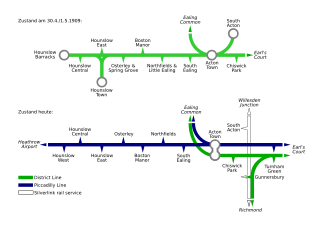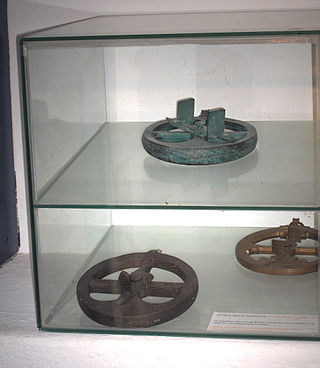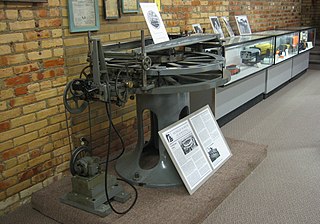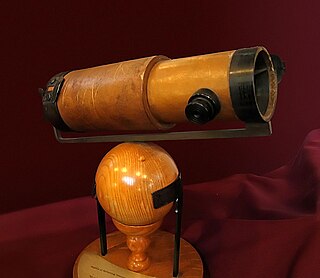Early reflecting instruments
Some of the early reflecting instruments were proposed by scientists such as Robert Hooke and Isaac Newton. These were little used or may not have been built or tested extensively. The van Breen instrument was the exception, in that it was used by the Dutch. However, it had little influence outside of the Netherlands.
Joost van Breen's reflecting cross-staff
Invented in 1660 by the Dutch Joost van Breen, the spiegelboog (mirror-bow) was a reflecting cross staff. This instrument appears to have been used for approximately 100 years, mainly in the Zeeland Chamber of the VOC (The Dutch East India Company). [1]
Robert Hooke's single-reflecting instrument

The index with telescope mounted is shown in black, the radius arm with the mirror (grey) attached in blue and the chord in green on white. The lines of sight are represented by the red dashed line.
Hooke's instrument was a single-reflecting instrument. It used a single mirror to reflect the image of an astronomical object to the observer's eye. [2] This instrument was first described in 1666 and a working model was presented by Hooke at a meeting of the Royal Society some time later.
The device consisted of three primary components, an index arm, a radial arm and a graduated chord. The three were arranged in a triangle as in the image on the right. A telescopic sight was mounted on the index arm. At the point of rotation of the radial arm, a single mirror was mounted. This point of rotation allowed the angle between the index arm and the radial arm to be changed. The graduated chord was connected to the opposite end of the radial arm and the chord was permitted to rotate about the end. The chord was held against the distant end of the index arm and slid against it. The graduations on the chord were uniform and, by using it to measure the distance between the ends of the index arm and the radial arm, the angle between those arms could be determined. A table of chords was used to convert a measurement of distance to a measurement of angle. The use of the mirror resulted in the measured angle being twice the angle included by the index and the radius arm.
The mirror on the radial arm was small enough that the observer could see the reflection of an object in half the telescope's view while seeing straight ahead in the other half. This allowed the observer to see both objects at once. Aligning the two objects together in the telescopes view resulted in the angular distance between them to be represented on the graduated chord.
While Hooke's instrument was novel and attracted some attention at the time, there is no evidence that it was subjected to any tests at sea. [2] The instrument was little used and did not have any significant effect on astronomy or navigation.
Halley's reflecting instrument
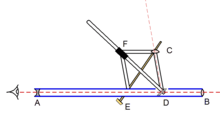
In 1692, Edmond Halley presented the design of a reflecting instrument to the Royal Society. [2]
This is an interesting instrument, combining the functionality of a radio latino with a double telescope. The telescope (AB in the adjacent image), has an eyepiece at one end and a mirror (D) partway along its length with one objective lens at the far end (B). The mirror only obstructs half the field (either left or right) and permits the objective to be seen on the other. Reflected in the mirror is the image from the second objective lens (C). This permits the observer to see both images, one straight through and one reflected, simultaneously besides each other. It is essential that the focal lengths of the two objective lenses be the same and that the distances from the mirror to either lens be identical. If this condition is not met, the two images cannot be brought to a common focus.
The mirror is mounted on the staff (DF) of the radio latino portion of the instrument and rotates with it. The angle this side of the radio latino's rhombus makes to the telescope can be set by adjusting the rhombus' diagonal length. In order to facilitate this and allow for fine adjustment of the angle, a screw (EC) is mounted so as to allow the observer to change the distance between the two vertexes (E and C).
The observer sights the horizon with the direct lens' view and sights a celestial object in the mirror. Turning the screw to bring the two images directly adjacent sets the instrument. The angle is determined by taking the length of the screw between E and C and converting this to an angle in a table of chords.
Halley specified that the telescope tube be rectangular in cross section. This makes construction easy, but is not a requirement as other cross section shapes can be accommodated. The four sides of the radio latino portion (CD, DE, EF, FC) must be equal in length in order for the angle between the telescope and the objective lens side (ADC) to be precisely twice the angle between the telescope and the mirror (ADF) (or in other words – to enforce the angle of incidence being equal to the angle of reflection). Otherwise, instrument collimation will be compromised and the resulting measurements would be in error.
The celestial object's elevation angle could have been determined by reading from graduations on the staff at the slider, however, that's not how Halley designed the instrument. This may suggest that the overall design of the instrument was coincidentally like a radio latino and that Halley may not have been familiar with that instrument.
There is no knowledge of whether this instrument was ever tested at sea. [2]
Newton's reflecting quadrant
Newton's reflecting quadrant was similar in many respects to Hadley's first reflecting quadrant that followed it.
Newton had communicated the design to Edmund Halley around 1699. However, Halley did not do anything with the document and it remained in his papers only to be discovered after his death. [3] However, Halley did discuss Newton's design with members of the Royal Society when Hadley presented his reflecting quadrant in 1731. Halley noted that Hadley's design was quite similar to the earlier Newtonian instrument. [2]
As a result of this inadvertent secrecy, Newton's invention played little role in the development of reflecting instruments.



